Our awesome professor, Dr. Curt Hansman, was interviewed by the Global Asian Studies Department. In her interview she discusses the importance of Art History and Global Asian Studies, no matter your major! Check out both videos below.
Our awesome professor, Dr. Curt Hansman, was interviewed by the Global Asian Studies Department. In her interview she discusses the importance of Art History and Global Asian Studies, no matter your major! Check out both videos below.
We have some big changes in the department! Dr. Joanna Gardner-Huggett is becoming an Associate Dean in the LAS Dean’s Office and so will no longer be chair of the department. We are incredibly excited for Dr. Gardner-Huggett and wish her all the best (and don’t worry, she’ll still be teaching classes for us!).
Professor Mark DeLancey will be the new chair of the Department of History of Art and Architecture. We know that he’ll be a great chair!
A big congratulations to both of them!
Where are you from?
Originally from New Jersey, with detours in North Carolina, Georgia, Wisconsin and Ohio before moving to Chicago 5 years ago.
What year did you graduate from DePaul?
2018
Why did you choose to go to DePaul?
I chose DePaul for the Art History program, because it seemed more well-rounded than other schools I was applying to. On top of that, the number of people I met from DePaul reassured me that there would be a strong network of alumni once I graduated.
Did you have any other majors or minors?
I also minored in Media and Cinema Studies in the College of Communication.
What attracted you to HAA?
I fell in love with art history by visiting the Art Institute after moving to Chicago. From there, I discovered that HAA would be the program to give me not only a strong foundation in the field but also the contacts and networking skills to build a career post-graduation. On top of that, I saw options for non-Western art history courses that I couldn’t find at other institutions.
What are your major interests in art and architectural history?
My practice draws heavily from the tradition of African diasporic art movements, with a focus on archiving and preserving records of community-engaged art and performance from the past and present. I am currently moving and reading through the aesthetic conditions that fed into the twin births of house/ball culture and hip-hop culture. This is an extension of work I did while at DePaul related to the role of graffiti in political activism.
Do you have any favorite classes or HAA faculty?
Top 3 faculty (in no particular order): Mark DeLancey, Lisa Mahoney, Susan Solway
What are you doing post-graduation?
A lot (but that’s always been the case). I am currently the Curatorial Assistant with Free Write Arts & Literacy and I work as a barista at Steppenwolf Theatre Company (the hustle doesn’t end when you graduate). I am also developing a performance and multimedia art project that straddles the axis of joy and pain intrinsic in the experience of the Black queer sight/body.
Can you tell us about your current position? What do you do? How did you start to work there?
Free Write Arts & Literacy engages incarcerated and court-involved youth and young adults in the performing, visual, and literary arts so that they become the narrators of their own stories and the authors of their futures. As Curatorial Assistant, I am organizing an upcoming exhibition entitled In Conversation. This show combines work from students in Cook County Juvenile Temporary Detention Center with response pieces by over 30 internationally recognized artists. The exhibition opens on june 14th at Chicago Art Department in Pilsen, and will be supported by Free Write’s first fundraising benefit MoneyBall on June 22nd.
I met Free Write’s Lead Curator, Chelsea Ross, in 2017 while I was working with Threewalls, a space for community and artist-focused programming in Humboldt Park. We activated her as a selection committee member for the performance series In Session, a spin on the traditional lecture that combines conversation with performance for transformative results. Chelsea reached out in March to see if I was interested in working on In Conversation, and I jumped at the chance to amplify the stories of individuals impacted by the carceral justice system.
How did the HAA major prepare you for your chosen profession and post-undergraduate life?
The research and presentation skills I cultivated through the HAA major have been indispensable since leaving school. HAA is a writing-heavy program, and the required time management alongside that forced me to prioritize deadlines and find the most effective ways to absorb information. All of these skills have helped me not only with my curatorial practice, but with interpersonal relationships as well.
The Second Annual DePaul Gnome Hunt is almost here! From February 25th through March 1st gnomes from 150 DePaul departments and student organizations will be hidden on the Loop and Lincoln Park Campuses (including our little dude, Vincent van Gnome!). If you find one of these gnomes, return them to the Office of Student Involvement and you’ll win DePaul gear, a Chartwell’s giftcard, or more.
If you find Vincent van Gnome, please take a picture with him and update us on how he’s doing! We can’t wait to see what he’s up to in his travels!
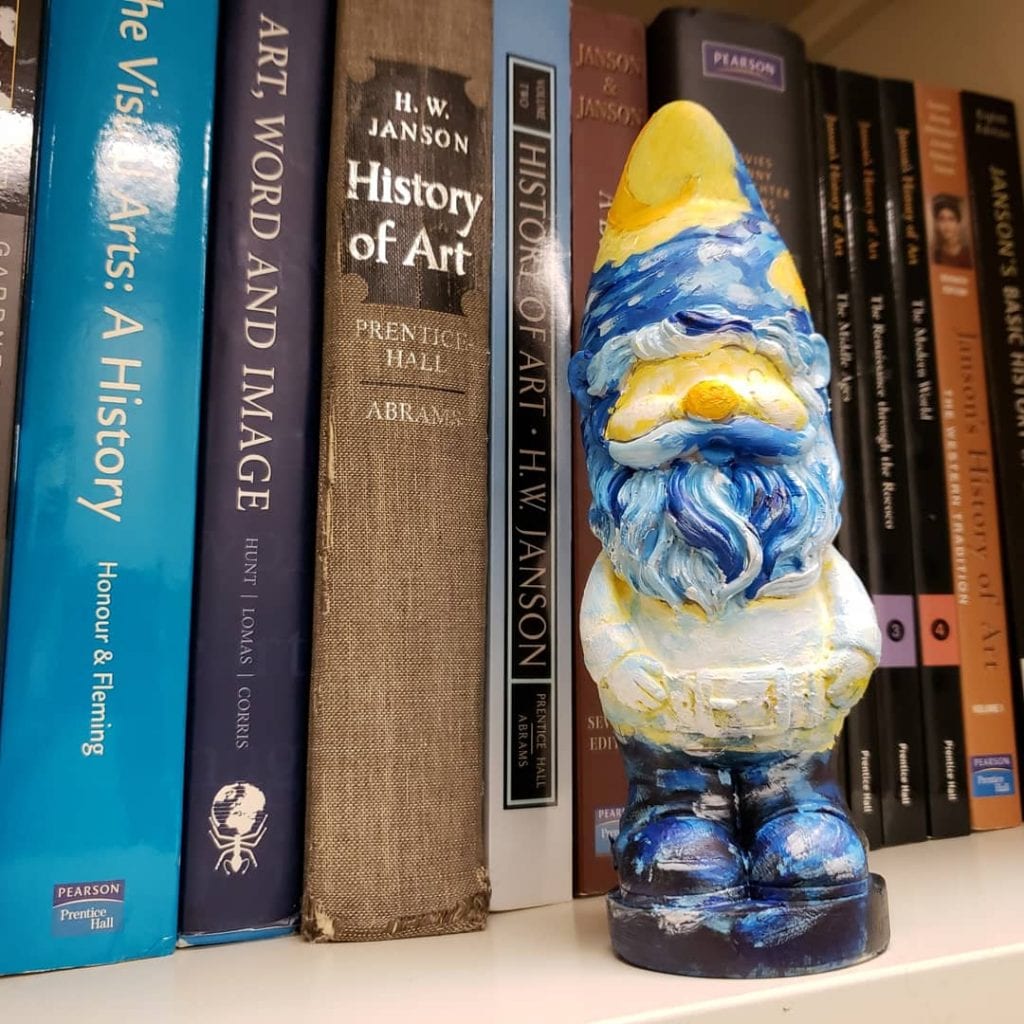
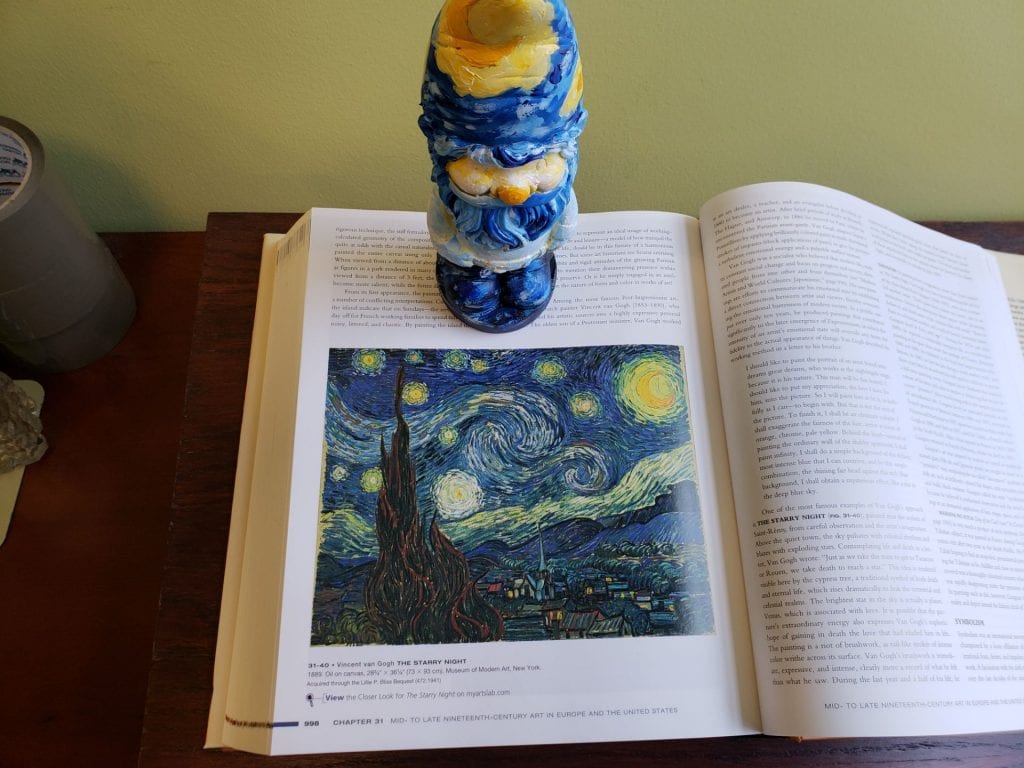
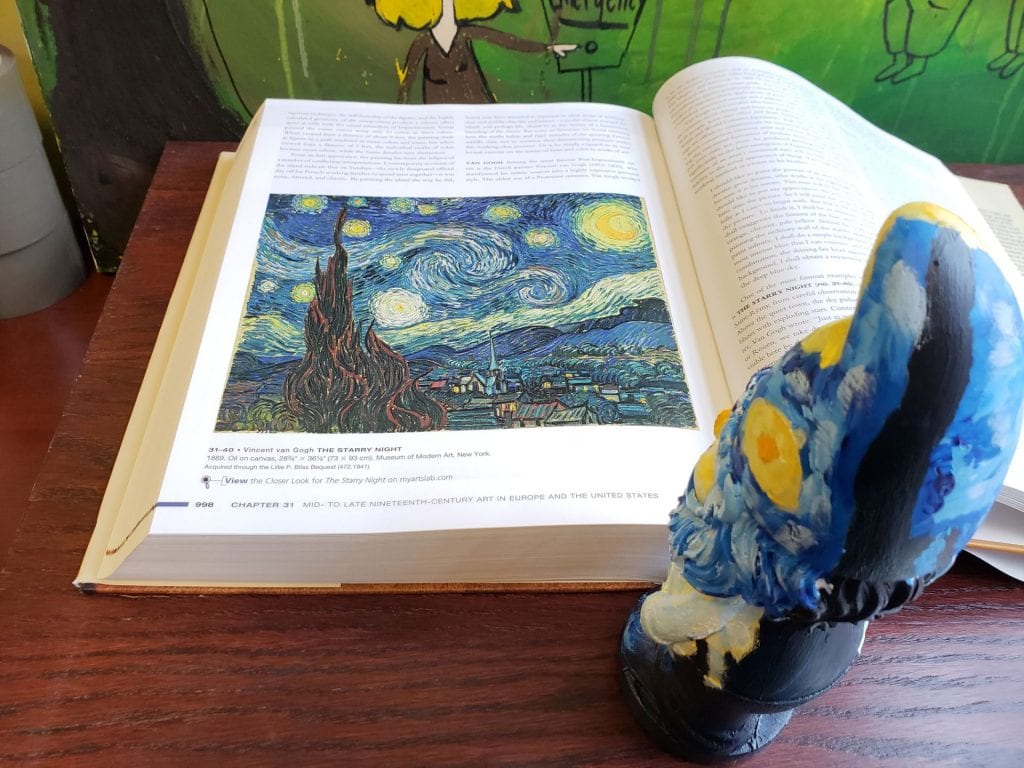
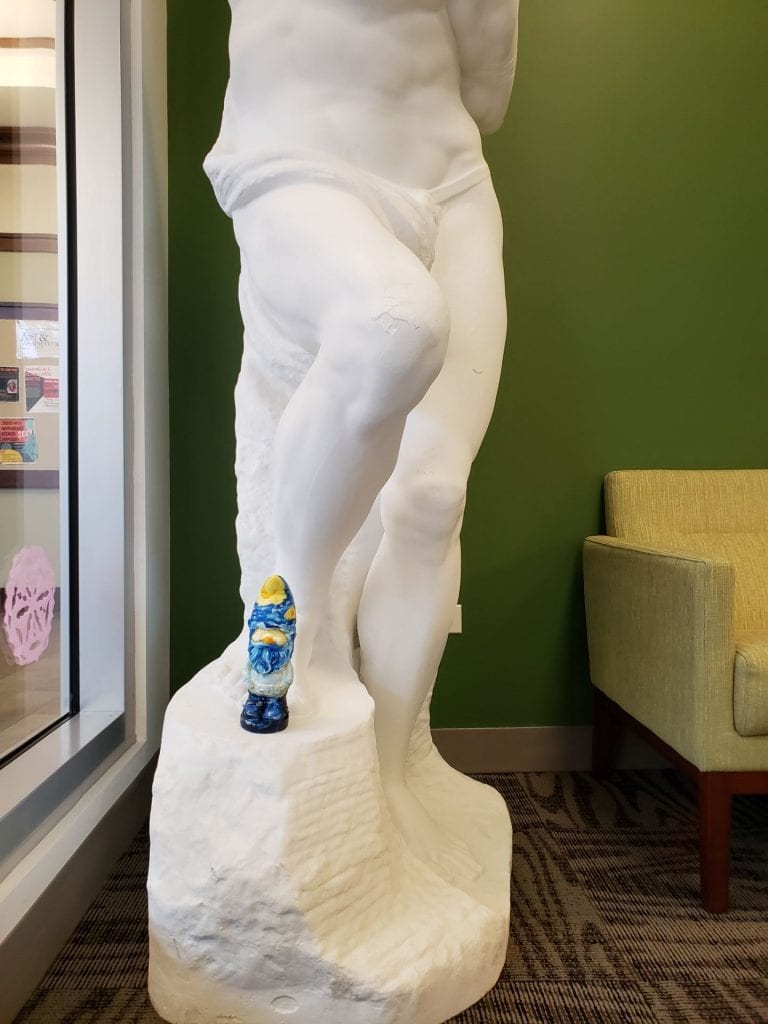
Every year, the Department of History of Art and Architecture puts on a Student Symposium and Essay Prize and this one is extra special, as this year is our 10 year anniversary as our own department!
Student Symposium
In previous years, the Student Symposium was open to all students who had taken a 200 or 300 level HAA class. However, we have changed things a little this year. As a way to showcase the culmination of work for the students in our HAA 390: Senior Capstone class, the only students who will be presenting at the symposium will be our capstone students. However, everyone is welcome to attend the symposium! The capstone gives our students a chance to refine and expand a paper that they have previously written. It also gives our students a chance to work on a topic that they are interested in researching more in depth, as well as creating a paper that they can use for graduate school applications. Anyone who attends the symposium will have a chance to hear the final work of our students, learn about what our current students are working on, and get an idea about the depth and breadth or our department research.
Essay Prize
Still want to take part in the Student Symposium, but aren’t in the Senior Capstone? No problem! Submit your paper for our annual paper prize! If you have a paper from 290 or any 300 level HAA course taken between Winter Quarter 2018 and Fall Quarter 2018 your paper is eligible. The annual paper prize comes with a monetary prize and the possibility that it will be published in the Creating Knowledge journal (if you’re interested in reading past winning papers, check out past Creating Knowledge publications!). If you apply to the essay prize, you must attend the symposium.
We’re taking applications for both now. You can find more information by visiting our departmental web page or emailing me at mmarnell@depaul.edu.
We can’t wait to hear and read all of the wonderful papers!
After a lot of blood, sweat, and tears being shed, debates on the proper categories, and at least one back being thrown out trying to lift many, many, many art history survey books (those suckers are heavy), our library is finally open!
If you’re an HAA student you definitely want to check out the library! The books range from survey books, to reference books, to books on a particular artist or movement. We even have journals and catalogs. Some of the books include ones that are used by our professors for their classes or have been donated by our professors.
While you can’t check out books, if you bring a flash drive the front desk staff can help you scan a chapter or image from a book and you’re welcome to sit and read during open hours.
We do have a few rules:
If you aren’t an HAA student you are still more than welcome to check out the library as well. You may even want to take a gander at some of our books, you might find a hitherto unknown love for art history!
Want to know what we have in our library ahead of time? You can check that out here. The library is in our suite, Arts and Letters Hall, suite 411.
We hope that everyone had a lovely first week of classes! All of our classes have been wonderful so far and everyone here is very excited for the rest of the quarter!
We have a few events in February (which seems to be approaching faster than it should be!) that I want to mention so that you can save the date!
The first event, taking place on Tuesday, February 5th at 5:30 is “The Fate of Art in Vienna during the Nazi Era”, a talk by Dr. Victoria Reed, who is the Monica S. Sadler Curator for Provenance at the Museum of Fine Arts, Boston. This event is offered through the law school, but is co-sponsored by many departments, including our own! This should be a fascinating talk for anyone interested in provenance research or art law.
The very next night will be our annual History of Art and Architecture Career Night! This event will have both Dr. Joanna Gardner-Huggett, the chair of HAA, as well as Margaret McGee-Newton from the Career Center answering questions about careers options with a major or minor in art history, how the DePaul Career Center can help you as you explore those options, and other questions you may have. You’re more than welcome to attend, even if you aren’t sure if art history is the thing for you!
The final one is that Saturday, February 9th (talk about a busy week!). This one isn’t at DePaul, but is at one of our partner institutions, the Art Institute of Chicago. JAM or Jobs at Art Museums is open to students as well as faculty and staff of area universities It’s a full day of career-focused programming at AIC and will include a museum careers panel, breakout sessions with museum staff, and information on internships and job opportunities (as well as a reception!). You can find more information here. After learning about some awesome jobs at the HAA Career Night earlier in the week, you can get a more in-depth look at career opportunities at art museums as well as gain networking with other students, faculty, and staff from nearby institutions.
We can’t wait to see you at these amazing events!
We’re back after an incredibly productive and busy holiday break!
(that’s a lie, we basically looked like this all break)
Resting
1891
Ernest Ange Duez
We hope that you had a wonderful holiday break as well!
As we gear up for the start of Winter Quarter (classes start on January 7th, whaaaaat?) we want to tell you about some awesome classes offered in Winter that aren’t getting the love they deserve.
First up is HAA 203: Post-Colonial African Art taught by Professor Mark DeLancey!
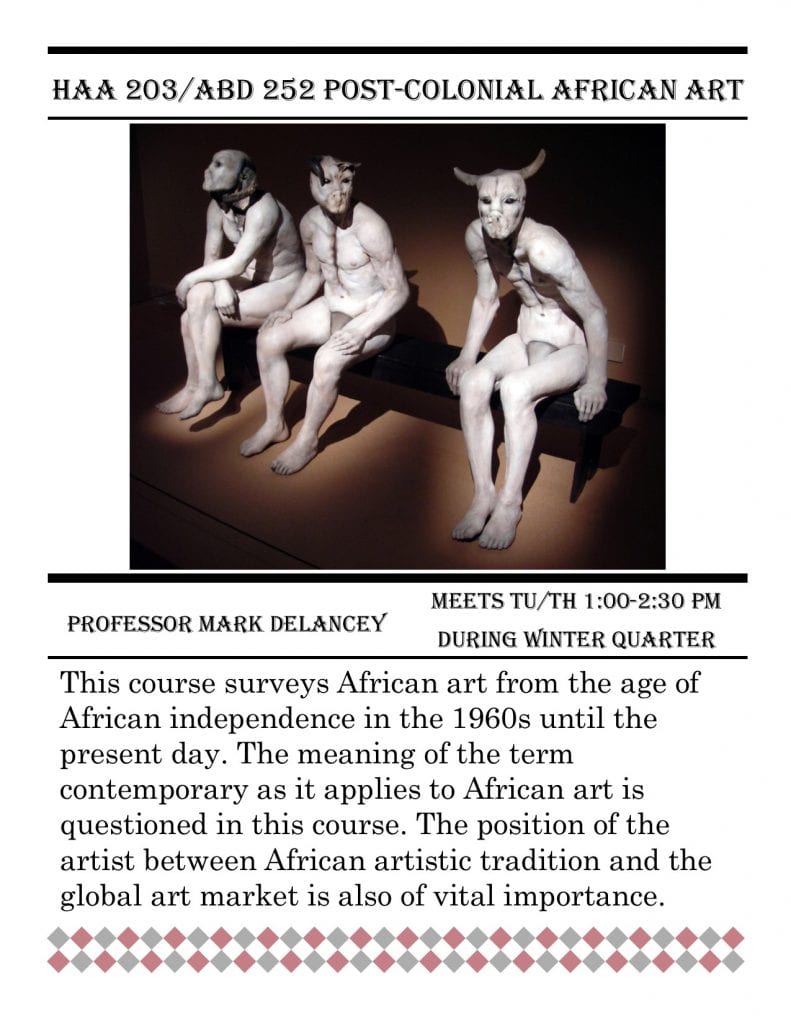 The Demons may not be blue, but they’re still pretty cool looking!
The Demons may not be blue, but they’re still pretty cool looking!
The next course is HAA 215: Chinese Art with Professor Curt Hansman
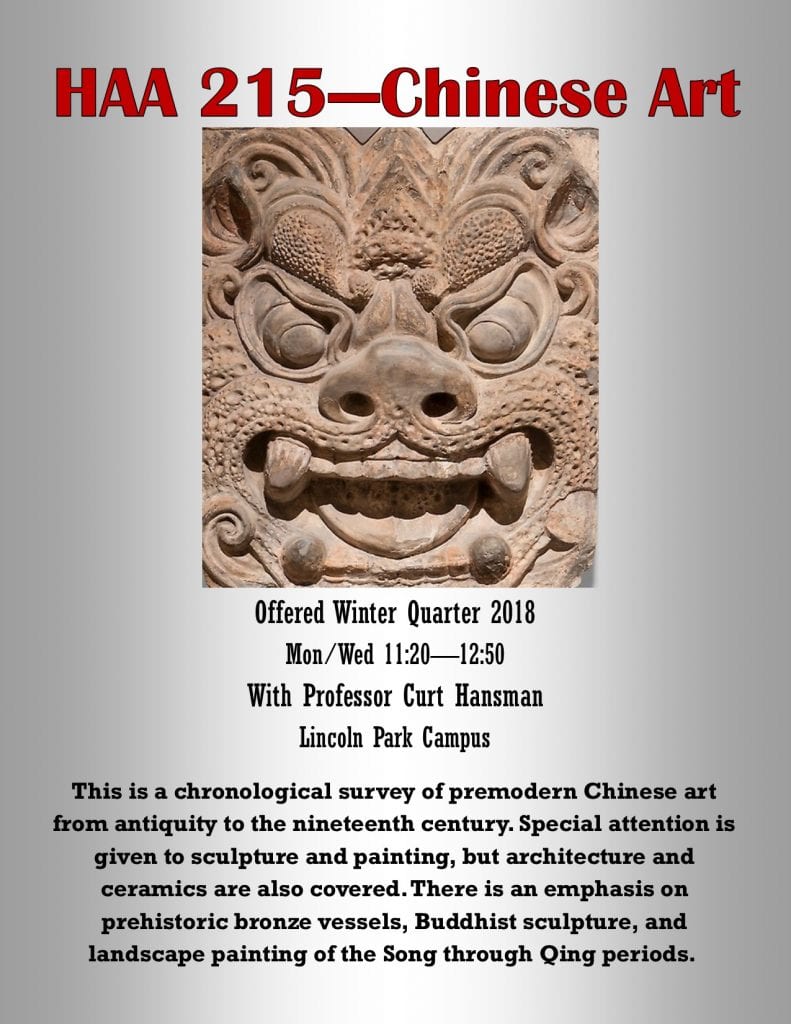
Both of these classes promise to be amazing classes!
We have many other classes on offer as well, such as Introduction to European Art, Art and Empire in the Ancient World, and Art From 1945 – 1975. As always, you can check what classes are being offered in a particular quarter by going here. If you’re a History of Art and Architecture Major, it’s important to note that HAA 390: Senior Capstone is being offered in Winter as well, which is the only quarter it will be offered this year.
We can’t wait to see you once this quarter starts!
Hello!
This is the blog for the Department of History of Art and Architecture at DePaul University in Chicago, IL. We plan to post news about the Department, as well as student news, and some art history news.
A little about us, first! Unless otherwise stated, blog posts are written by Margaret Marnell, the Program Assistant for the Department. You can reach her by e-mail at mmarnell@depaul.edu.
The Department of History of Art and Architecture strives to familiarize our students with works of art that define civilizations around the world from their emergence to the present day. Art history, interdisciplinary by its very nature, examines culture, religion, politics, and environment. The study of art history can prepare you for a variety of careers and post-graduate pursuits, and our classes foster critical thinking skills by developing visual literacy, close reading, persuasive writing, research skills, and oral communication. Art has been used by cultures for millennia to communicate, worship, persuade, and express thoughts (to name just a few). By learning how to analyze and think critically about these pieces, we gain a deeper understanding of what was, and is, important to the cultures and people who created the works. We learn about people who have a different understanding of the world. We start to understand our similarities and differences with people from a different time, place, and culture.
If you’re still wondering, “why art history?” here are a few things that might surprise you. Art history is regularly used by medical schools to help their students learn to observe, empathize, and think critically about their observations; and going to an art museum is starting to be investigated by doctors as a supplement to medical treatments. Police departments are starting to use art history to teach their officers the same skills of observing, empathizing, and thinking critically. Art is quickly becoming a major investment and knowledge of art movements and art history can help one invest wisely. There is a whole section of law focused on the art world that deals with everything from copyright infringement to cultural patrimony and repatriation (DePaul University even has a Center for Art, Museum and Cultural Heritage Law). The FBI even has a team that focuses purely on art crime. Art history isn’t just in a museum, it’s all around us.
Our faculty is one of the most academically diverse in Chicago and we offer classes ranging from survey classes, which are appropriate for people who have no art history background, through upper level classes that are focused on a particular topic, such as “Women in Art”, and “Duchamp and DADAism”. You can see course descriptions for all of our regular classes by visiting the Course Catalog and selecting “Art and Architecture, History of”. We bring regular guest speakers who are experts in the field to give lectures, most of which are open to the public, on special topics. We have a yearly Student Symposium and Paper Prize, where our students present their work to peers and faculty. DePaul has a partnership with the Art Institute of Chicago so our students, faculty, and staff have free admission to the museum (which we take advantage of in our classes). We have a DePaul Night at the Art Institute of Chicago, where faculty, students, and alumni give talks and gallery tours. We also have a student History of Art and Architecture Club which plans field trips and other student focused events.
In addition to the Major in History of Art and Architecture, we also offer three minors: a Minor in History of Art and Architecture, a Minor in Museum Studies, which is offered jointly with the Departments of History, and Anthropology, and the Cities Minor which is offered jointly with the Department of Geography. The Minor in History of Art and Architecture draws students from a huge variety of majors. Because art history is so interdisciplinary, many students find that it is easy for them to connect it in a meaningful way to their major while gaining valuable research and writing skills. The Museum Studies Minor is an interdisciplinary endeavor that addresses the theory, organization, and management of museums and museum collections. Museums themselves are complex organizations within which a diversity of knowledge specialists work together to acquire, conserve, research, communicate and exhibit tangible and intangible evidence of people and their environment. The Cities Minor, meanwhile, explores the variety of ways in which the spaces of cities relate to their historical/geographical materiality. In this sense, culture is broadly construed to encompass the spatial, aesthetic, linguistic, and other social practices that define the material and phenomenological particularities of cities.
If you want to learn more, you can visit us on our Twitter, our Facebook, or on our website. You can find contact information for us here, or you can just say hi on this blog. We’d love to hear from you!